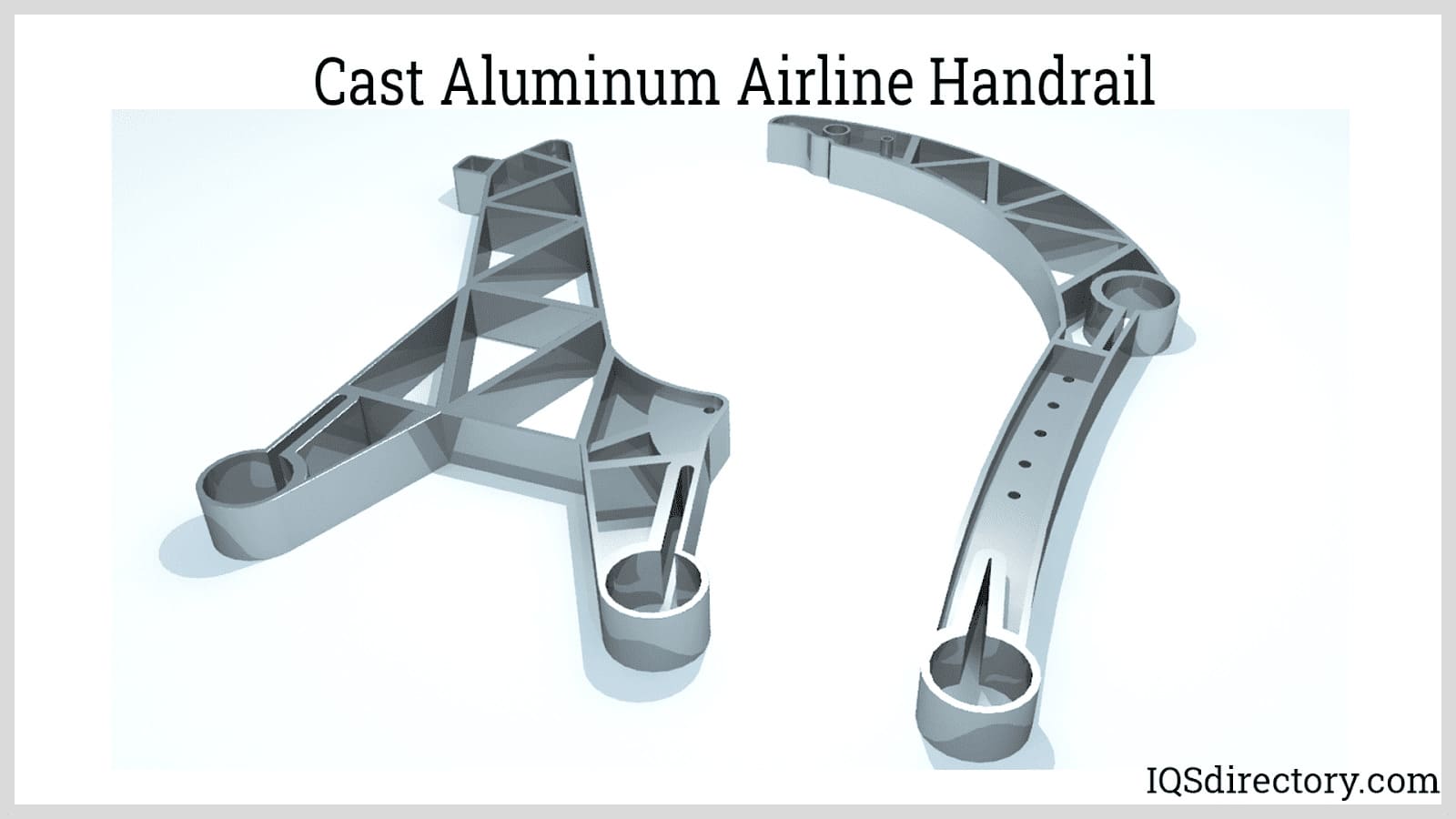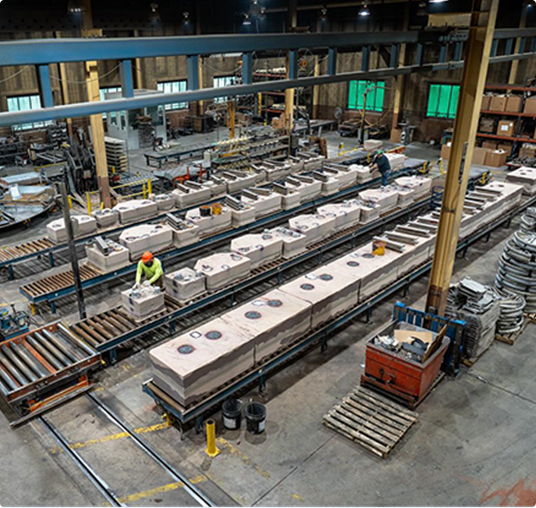Exactly How Aluminum Foundry Contributes to Innovative Solutions in Steel Fabrication
Aluminum foundries significantly affect the landscape of steel construction. They adopt advanced casting strategies that boost precision and style flexibility. This ability permits the production of long lasting and lightweight components that deal with diverse industry needs. Furthermore, the assimilation of automation and sustainable practices establishes a standard for performance. As these factories progress, they question regarding the future of production and the duty of technology in forming the market.
The Function of Aluminum Foundries in Modern Production
Aluminum shops play a necessary function in contemporary manufacturing, contributing significantly to various sectors, including automobile, aerospace, and durable goods. These centers focus on the melting and casting of light weight aluminum, changing resources right into premium parts that meet strict sector requirements. The lightweight yet solid residential or commercial properties of Aluminum make it an ideal selection for suppliers intending to boost performance while decreasing weight, particularly in the automobile sector, where fuel efficiency is paramount.
Light weight aluminum factories use cutting-edge processes to generate complicated forms and designs that provide to particular market needs. By leveraging innovative technologies such as computer-aided style and simulation, these factories can maximize their production procedures and boost material use. This not only boosts the high quality of the last items yet additionally minimizes waste, adding to even more sustainable production practices. Inevitably, the contributions of Aluminum factories are vital for driving technology and performance throughout several industries.
Advanced Casting Techniques Transforming Metal Construction
Advanced spreading techniques are transforming the field of metal manufacture, specifically via precision casting approaches that boost accuracy and minimize waste. Innovative alloy developments are additionally playing an essential duty, enabling customized buildings and improved efficiency in numerous applications. Together, these advancements are establishing brand-new requirements in effectiveness and quality within Aluminum factories.
Precision Spreading Techniques
As the demand for premium elements in various sectors proceeds to increase, accuracy casting methods have actually emerged as a transformative force in steel construction. These strategies, including financial investment casting, lost foam casting, and pass away spreading, permit intricate geometries and tight tolerances that traditional techniques often have a hard time to attain. By using advanced products and technologies, precision casting lessens waste and enhances performance, enabling suppliers to generate complicated get rid of lowered preparations. In addition, these methods offer premium surface coatings and mechanical residential or commercial properties, making them excellent for industries such as aerospace, auto, and medical devices. As makers increasingly adopt accuracy casting, the ability to meet details design requirements while maintaining cost-effectiveness becomes a critical advantage in today's affordable market.
Cutting-edge Alloy Dopes
Innovative alloy advancements are improving the landscape of metal construction, especially within the domain of precision spreading. Breakthroughs in material scientific research have actually caused the production of specialized Aluminum alloys that boost resistance, toughness, and toughness to corrosion. These unique alloys enable factories to generate complex components with improved mechanical residential or commercial properties, satisfying varied sectors such as aerospace, automotive, and electronics. The unification of advanced casting methods, including die casting and sand casting, more enhances making use of these materials, enabling intricate geometries and decreased waste. Because of this, makers are better equipped to satisfy strict performance requirements while decreasing ecological impact. Inevitably, these innovative alloys are leading the way for a brand-new age of effectiveness and sustainability in metal construction.
Lightweight and Long Lasting: The Advantages of Aluminum Components
Aluminum elements use considerable benefits in different applications due to their light-weight nature and resilience. This combination adds to enhanced gas efficiency, especially in the aerospace and automobile industries. In addition, aluminum's intrinsic rust resistance even more extends the life expectancy of items, making it a favored selection in lots of metal manufacture procedures.
Enhanced Fuel Efficiency
While typical materials have actually long been the requirement in numerous industries, the shift in the direction of Aluminum parts is revolutionizing the landscape of steel construction, especially in regard to improved gas efficiency. Light weight aluminum's light-weight nature especially decreases the total weight of cars and machinery, permitting for enhanced efficiency and lowered power consumption. This reduction in weight converts straight to lower gas intake, making Aluminum an appealing alternative for suppliers intending to meet rigorous ecological guidelines. Additionally, aluminum's toughness warranties that parts preserve their integrity gradually, adding to lasting effectiveness. As markets progressively prioritize sustainability, the fostering of Aluminum parts ends up being a calculated choice, aligning operational objectives with environmental obligation while enhancing gas efficiency in different applications.
Corrosion Resistance Advantages
One of the standout attributes of Aluminum elements is their phenomenal deterioration resistance, which considerably boosts the long life and integrity of various applications. This property is especially useful in extreme atmospheres, such as marine and industrial setups, where exposure to wetness and chemicals can result in considerable degradation in other metals. Unlike steel, Aluminum naturally creates a protective oxide layer that acts as an obstacle against environmental elements, minimizing the threat of rust and corrosion. Therefore, Aluminum parts need less maintenance and have a longer life span, making them a cost-effective selection for manufacturers. This integral durability not only adds to the total performance of items yet likewise sustains sustainability efforts by minimizing the demand for frequent substitutes.
Technologies in Style and Design Through Aluminum Foundries
As improvements in Aluminum Foundry technology remain to improve the landscape of steel construction, ingenious layout and design services are emerging to meet the demands of varied industries. The adaptability of Aluminum permits elaborate styles that were formerly unattainable with conventional products. Factories are leveraging computer-aided style (CAD) software program and simulation devices to optimize the design process, enabling engineers to produce lightweight yet durable components tailored to certain applications.
The capability to incorporate advanced alloying strategies allows the modification of Aluminum residential or commercial properties, enhancing strength and durability. This adaptability fosters imagination in item development, enabling business to try out new forms and frameworks that enhance performance while decreasing weight. Joint initiatives in between foundries and developers facilitate fast prototyping, leading to shorter task timelines and enhanced general performance. These innovations not just boost product efficiency yet likewise drive sustainability by reducing material waste throughout the construction procedure.
Enhancing Performance With State-Of-The-Art Technology
Innovations in state-of-the-art modern technology are reinventing the efficiency of Aluminum factories, improving processes from design to manufacturing. Automation plays a pivotal duty, with robotic systems improving the rate and precision of tasks such as molding, putting, and finishing. These automated remedies reduce human mistake and decrease labor prices, while additionally boosting result uniformity.
Additionally, the assimilation of sophisticated software for computer-aided layout (CAD) and simulation enables fast prototyping and screening, quickening the shift from idea to manufacturing. Factories are using real-time information analytics to keep an eye on procedures, making certain original site peak efficiency and decreasing downtime.
Additionally, 3D printing innovation is being adopted for developing complicated molds and components, lowering product waste and preparation. The mix of these sophisticated technologies not just boosts productivity however also enhances the top quality of Aluminum items, positioning foundries at the forefront of technology in steel manufacture.
Lasting Practices in Aluminum Foundries
An expanding number of Aluminum shops are embracing sustainable methods to minimize their ecological influence and promote source performance. Aluminum Castings. These shops are significantly applying reusing programs, where scrap Aluminum is gathered and recycled, substantially decreasing waste. Additionally, energy-efficient technologies, such as electric heaters and progressed insulation materials, are being utilized to reduced power consumption throughout the melting process
Water preservation techniques are additionally getting grip, with numerous foundries recycling water in cooling down systems to reduce total use. The fostering of eco-friendly layers and additives decreases harmful discharges without endangering product quality.
Future Fads in Aluminum Casting and Metalworking
Progressively, the future of Aluminum casting and metalworking is being formed by technological developments and progressing sector criteria. Improvements in automation and robotics are streamlining procedures, improving precision, and lowering labor costs. The adoption of additive manufacturing strategies, such as 3D printing, is transforming traditional spreading methods, enabling complex geometries and reduced material waste.
Additionally, the combination of expert system and information analytics is enabling real-time surveillance and anticipating maintenance, which optimizes production performance. Sustainability continues to be a core focus, with firms purchasing environmentally friendly techniques, including the recycling of Aluminum scrap and using renewable resource resources in manufacturing.
As the demand for lightweight, sturdy products in numerous industries boosts, Aluminum foundries must adjust by improving and establishing cutting-edge alloys spreading strategies. These fads jointly indicate a future where Aluminum spreading and metalworking are extra effective, lasting, and receptive to market demands.

Regularly Asked Inquiries
What Kinds of Aluminum Alloys Are Generally Made Use Of in Factories?
Frequently utilized Aluminum alloys in foundries include 2xxx series (copper), 3xxx series imp source (manganese), 4xxx series (silicon), 5xxx collection (magnesium), and 6xxx collection (magnesium and silicon), each offering special residential properties appropriate for numerous applications.
Just How Does Aluminum Spreading Compare to Other Metal Manufacture Approaches?
Aluminum casting deals advantages such as lower production prices and intricate forms compared to conventional construction approaches. It supplies outstanding dimensional accuracy and surface finish, making it a recommended option for many markets over options like machining or welding.
What Precaution Are Implemented in Aluminum Foundries?
Aluminum shops execute various precaution, consisting of individual safety devices, air flow systems, regular safety training, hazard assessments, and emergency situation protocols to secure workers from risks linked with molten steel, warmth, and prospective chemical exposure. Aluminum Castings.
Just How Can Business Locate Trustworthy Aluminum Foundry Partners?
Firms can determine trusted Aluminum Foundry partners by evaluating industry credibility, examining customer testimonials, assessing high quality accreditations, considering production capabilities, and carrying out site check outs to ensure positioning with their specific needs and requirements.

What Is the Regular Preparation for Aluminum Spreading Projects?
The regular lead time for Aluminum spreading projects ranges from 2 to 8 weeks, depending upon factors such as style complexity, production quantity, and the factory's capability to satisfy particular job needs and timelines.
Aluminum shops play a crucial role in modern-day production, contributing considerably to numerous markets, consisting of automobile, aerospace, and customer Check This Out goods. As developments in Aluminum Foundry innovation continue to improve the landscape of steel manufacture, innovative style and design services are arising to satisfy the needs of varied industries. Developments in state-of-the-art innovation are revolutionizing the performance of Aluminum factories, simplifying processes from design to production (Aluminum Castings). An expanding number of Aluminum foundries are taking on sustainable methods to minimize their ecological impact and advertise source performance. As the need for light-weight, sturdy materials in numerous markets boosts, Aluminum factories should adjust by developing cutting-edge alloys and improving spreading strategies